Pulsed Laser Welding Applied to Metallic Materials—A Material Approach
Abstract
1. Introduction
1.1. Description
1.2. Microstructural Evolution
1.3. Industrial Applications
1.4. Scientific Developments
1.5. Scope
2. Materials
2.1. Steels
2.1.1. Low Alloy and Carbon Steels
2.1.2. Dual Phase (DP)
2.1.3. Stainless Steel
2.1.4. Dissimilar Joints
2.2. Titanium
2.3. Aluminium
2.4. Superalloys
3. Outlook and Remarks
4. Summary
Author Contributions
Funding
Data Availability Statement
Acknowledgments
Conflicts of Interest
References
- Steen, W.M. Laser Material Processing; Springer: London, UK, 2003; Volume 113, ISBN 9781849960618. [Google Scholar]
- Chatterjee, S.; Sankar, S.; Bharadwaj, V.; Upadhyay, B.N.; Bindra, K.S.; Thomas, J. Parametric appraisal of mechanical and metallurgical behavior of butt welded joints using pulsed Nd:YAG laser on thin sheets of AISI 316. Opt. Laser Technol. 2019, 117, 186–199. [Google Scholar] [CrossRef]
- Kumar, N.; Mukherjee, M.; Bandyopadhyay, A. Study on laser welding of austenitic stainless steel by varying incident angle of pulsed laser beam. Opt. Laser Technol. 2017, 94, 296–309. [Google Scholar] [CrossRef]
- Dai, J.; Yu, B.; Ruan, Q.; Chu, P.K. Improvement of the laser-welded lap joint of dissimilar mg alloy and cu by incorporation of a Zn interlayer. Materials 2020, 13, 2053. [Google Scholar] [CrossRef]
- Chai, D.; Wu, D.; Ma, G.; Zhou, S.; Jin, Z.; Wu, D. The effects of pulse parameters on weld geometry and microstructure of a pulsed laser welding Ni-base alloy thin sheet with filler wire. Metals 2016, 6, 237. [Google Scholar] [CrossRef]
- Lerra, F.; Ascari, A.; Fortunato, A. The influence of laser pulse shape and separation distance on dissimilar welding of Al and Cu films. J. Manuf. Process. 2019, 45, 331–339. [Google Scholar] [CrossRef]
- Kumar, P.; Nath, S. Comparative analysis of pulsed Nd:YAG laser welding of 304L and 904L stainless steel. Mater. Today Proc. 2020, 33, 5019–5023. [Google Scholar] [CrossRef]
- Chang, W.S.; Na, S.J. A study on the prediction of the laser weld shape with varying heat source equations and the thermal distortion of a small structure in micro-joining. J. Mater. Process. Technol. 2002, 120, 208–214. [Google Scholar] [CrossRef]
- Abioye, T.E.; Zuhailawati, H.; Aizad, S.; Anasyida, A.S. Geometrical, microstructural and mechanical characterization of pulse laser welded thin sheet 5052-H32 aluminium alloy for aerospace applications. Trans. Nonferr. Met. Soc. China 2019, 29, 667–679. [Google Scholar] [CrossRef]
- Sánchez-Amaya, J.M.; Delgado, T.; González-Rovira, L.; Botana, F.J. Laser welding of aluminium alloys 5083 and 6082 under conduction regime. Appl. Surf. Sci. 2009, 255, 9512–9521. [Google Scholar] [CrossRef]
- Sun, Q.; Di, H.; Li, J.; Wang, X. Effect of pulse frequency on microstructure and properties of welded joints for dual phase steel by pulsed laser welding. JMADE 2016, 105, 201–211. [Google Scholar] [CrossRef]
- Landowski, M.; Świerczyńska, A.; Rogalski, G.; Fydrych, D. Autogenous fiber laser welding of 316L austenitic and 2304 lean duplex stainless steels. Materials 2020, 13, 2930. [Google Scholar] [CrossRef] [PubMed]
- Sahul, M.; Tomcíková, E.; Sahul, M.; Pašák, M.; Ludrovcová, B.; Hodúlová, E. Effect of Disk Laser Beam Offset on the Microstructure and Mechanical Properties of Copper—AISI 304 Stainless Steel Dissimilar Metals Joints. Metals 2020, 1294. [Google Scholar] [CrossRef]
- Pańcikiewicz, K.; Świerczyńska, A.; Hućko, P.; Tumidajewicz, M. Laser dissimilar welding of AISI 430F and AISI 304 stainless steels. Materials 2020, 13, 4540. [Google Scholar] [CrossRef]
- O’Brien, A.; Guzman, C. Welding Handbook- Part 2 Welding Processes, 9th ed.; Elsevier: Amsterdam, The Netherlands, 2007; Volume 3, ISBN 9780871710536. [Google Scholar]
- Sánchez-Amaya, J.M.; Delgado, T.; De Damborenea, J.J.; Lopez, V.; Botana, F.J. Laser welding of AA 5083 samples by high power diode laser. Sci. Technol. Weld. Join. 2009, 14, 78–86. [Google Scholar] [CrossRef]
- Kumar, N.; Mukherjee, M.; Bandyopadhyay, A. Comparative study of pulsed Nd:YAG laser welding of AISI 304 and AISI 316 stainless steels. Opt. Laser Technol. 2017, 88, 24–39. [Google Scholar] [CrossRef]
- Katayama, S. Handbook of Laser Welding Technologies; Woodhead Publishing Limited: Sawston, UK, 2013; ISBN 9788578110796. [Google Scholar]
- Yaakob, K.I.; Ishak, M.; Quazi, M.M.; Salleh, M.N.M. Optimizing the pulse wave mode low power fibre laser welding parameters of 22Mnb5 boron steel using response surface methodology. Meas. J. Int. Meas. Confed. 2019, 135, 452–466. [Google Scholar] [CrossRef]
- Indhu, R.; Divya, S.; Tak, M.; Soundarapandian, S. Microstructure development in Pulsed Laser Welding of Dual Phase Steel to Aluminium Alloy. Procedia Manuf. 2018, 26, 495–502. [Google Scholar] [CrossRef]
- Chludzinski, M.; dos Santos, R.E.; Churiaque, C.; Fernández-Vidal, S.R.; Ortega-Iguña, M.; Sánchez-Amaya, J.M. Pulsed laser butt welding of AISI 1005 steel thin plates. Opt. Laser Technol. 2021, 134, 106583. [Google Scholar] [CrossRef]
- Quazi, M.M.; Ishak, M.; Fazal, M.A.; Arslan, A.; Rubaiee, S.; Qaban, A.; Aiman, M.H.; Sultan, T.; Ali, M.M.; Manladan, S.M. Current research and development status of dissimilar materials laser welding of titanium and its alloys. Opt. Laser Technol. 2020, 126, 106090. [Google Scholar] [CrossRef]
- Katayama, S. Understanding and improving process control in pulsed and continuous wave laser welding. In Advances in Laser Materials Processing; Elsevier Ltd.: Amsterdam, The Netherlands, 2018; pp. 181–210. ISBN 9781845694746. [Google Scholar]
- Tzeng, Y.F. Process characterization of pulsed Nd:YAG laser seam welding. Int. J. Adv. Manuf. Technol. 2000, 16, 10–18. [Google Scholar] [CrossRef]
- Tzeng, Y.F. Parametric analysis of the pulsed Nd:YAG laser seam-welding process. J. Mater. Process. Technol. 2000, 102, 40–47. [Google Scholar] [CrossRef]
- Hekmatjou, H.; Naffakh-Moosavy, H. Hot cracking in pulsed Nd: YAG laser welding of AA5456. Opt. Laser Technol. 2018, 103, 22–32. [Google Scholar] [CrossRef]
- Tur, A.; Cordovilla, F.; García-Beltrán, Á.; Ocaña, J.L. Minimization of the thermal material effects on pulsed dynamic laser welding. J. Mater. Process. Technol. 2017, 246, 13–21. [Google Scholar] [CrossRef]
- Desai, R.S.; Bag, S. Influence of displacement constraints in thermomechanical analysis of laser micro-spot welding process. J. Manuf. Process. 2014, 16, 264–275. [Google Scholar] [CrossRef]
- Chaturvedi, M.C. Welding and Joining of Aerospace Materials; Woodhead Publishing Limited: Sawston, UK, 2012; ISBN 978-0-85709-523-7. [Google Scholar]
- Olsen, F.O. Hybrid Laser arc Welding, 2009th ed.; Woodhead Publishing Limited: Cambridge, UK, 2009; ISBN 9781845691301. [Google Scholar]
- Churiaque, C.; Amaya-Vazquez, M.R.; Botana, F.J.; Sánchez-Amaya, J.M. FEM Simulation and Experimental Validation of LBW Under Conduction Regime of Ti6Al4V Alloy. J. Mater. Eng. Perform. 2016, 25, 3260–3269. [Google Scholar] [CrossRef]
- Assuncao, E.; Williams, S. Comparison of continuous wave and pulsed wave laser welding effects. Opt. Lasers Eng. 2013, 51, 674–680. [Google Scholar] [CrossRef]
- Assuncao, E.; Williams, S.; Yapp, D. Interaction time and beam diameter effects on the conduction mode limit. Opt. Lasers Eng. 2012, 50, 823–828. [Google Scholar] [CrossRef]
- Torkamany, M.J.; Malek Ghaini, F.; Poursalehi, R.; Kaplan, A.F.H. Combination of laser keyhole and conduction welding: Dissimilar laser welding of niobium and Ti-6Al-4V. Opt. Lasers Eng. 2016, 79, 9–15. [Google Scholar] [CrossRef]
- Sibillano, T.; Ancona, A.; Berardi, V.; Schingaro, E.; Basile, G.; Lugarà, P.M. Optical detection of conduction/keyhole mode transition in laser welding. J. Mater. Process. Technol. 2007, 191, 364–367. [Google Scholar] [CrossRef]
- Sánchez-Amaya, J.; Pasang, T.; Amaya-Vazquez, M.; Lopez-Castro, J.; Churiaque, C.; Tao, Y.; Botana Pedemonte, F. Microstructure and Mechanical Properties of Ti5553 Butt Welds Performed by LBW under Conduction Regime. Metals 2017, 7, 269. [Google Scholar] [CrossRef]
- Chen, H.C.; Bi, G.; Lee, B.Y.; Cheng, C.K. Laser welding of CP Ti to stainless steel with different temporal pulse shapes. J. Mater. Process. Technol. 2016, 231, 58–65. [Google Scholar] [CrossRef]
- Ventrella, A.; Roberto, J.; Rossi, W. De Pulsed Nd:YAG laser seam welding of AISI 316L stainless steel thin foils. J. Mater. Process. Tech. 2010, 210, 1838–1843. [Google Scholar] [CrossRef]
- Mojaver, R.; Mojtahedi, F.; Shahverdi, H.R.; Torkamany, M.J. Study on feasibility of producing an amorphous surface layer of Fe 49 Cr 18 Mo 7 B 16 C 4 Nb 3 by pulsed Nd:YAG laser surface melting. Appl. Surf. Sci. 2013, 264, 176–183. [Google Scholar] [CrossRef]
- Mostaan, H.; Shamanian, M.; Hasani, S.; Safari, M.; Szpunar, J.A. Nd:YAG laser micro-welding of ultra-thin FeCo–V magnetic alloy: Optimization of weld strength. Trans. Nonferr. Met. Soc. China 2017, 27, 1735–1746. [Google Scholar] [CrossRef]
- Gao, X.L.; Liu, J.; Zhang, L.J.; Zhang, J.X. Effect of the overlapping factor on the microstructure and mechanical properties of pulsed Nd:YAG laser welded Ti6Al4V sheets. Mater. Charact. 2014, 93, 136–149. [Google Scholar] [CrossRef]
- Torabi, A.; Kolahan, F. Optimizing pulsed Nd: YAG laser beam welding process parameters to attain maximum ultimate tensile strength for thin AISI316L sheet using response surface methodology and simulated annealing algorithm. Opt. Laser Technol. 2018, 103, 300–310. [Google Scholar] [CrossRef]
- John, C. Lippold Welding Metallurgy and Weldability; John Wiley & Sons, Inc.: Hoboken, NJ, USA, 2015; ISBN 9789896540821. [Google Scholar]
- Linnert, G.E.; Kou, S.; Zhou, J.; Tsai, H.L.; Wang, P.C. Welding Metallurgy; Woodhead Publishing Limited: Sawston, UK, 2003; Volume 1, ISBN 3175723993. [Google Scholar]
- Gnanasekaran, S.; Senthil Kumar, S.; Venugopal, N.; Upadhyaya, M.; Manjunath, T.C.; Chelladurai, S.J.S.; Padmanaban, G. Effect of laser power on microstructure and tensile properties of pulsed Nd:YAG laser beam welded AISI 301 austenitic stainless steel joints. Mater. Today Proc. 2020, 37, 934–939. [Google Scholar] [CrossRef]
- Zhao, X.; Shi, Z.; Deng, C.; Liu, Y.; Li, X. The effect of laser offset welding on microstructure and mechanical properties of 301L to TA2 with and without Cu intermediate layer. Metals 2020, 10, 1138. [Google Scholar] [CrossRef]
- Mohammed, G.R.; Ishak, M.; Ahmad, S.N.A.S.; Abdulhadi, H.A. Fiber laser welding of dissimilar 2205/304 stainless steel plates. Metals 2017, 7, 546. [Google Scholar] [CrossRef]
- Li, J.; Cai, Y.; Yan, F.; Wang, C.; Zhu, Z.; Hu, C. Porosity and liquation cracking of dissimilar Nd:YAG laser welding of SUS304 stainless steel to T2 copper. Opt. Laser Technol. 2020, 122, 105881. [Google Scholar] [CrossRef]
- He, H.; Forouzan, F.; Volpp, J.; Robertson, S.M.; Vuorinen, E. Microstructure and mechanical properties of laser-welded DP steels used in the automotive industry. Materials 2021, 14, 456. [Google Scholar] [CrossRef] [PubMed]
- Trinh, L.N.; Lee, D. The characteristics of laser welding of a thin aluminum tab and steel battery case for lithium-ion battery. Metals 2020, 10, 842. [Google Scholar] [CrossRef]
- Quazi, M.M.; Ishak, M.; Fazal, M.A.; Arslan, A.; Rubaiee, S.; Aiman, M.H.; Qaban, A.; Yusof, F.; Sultan, T.; Ali, M.M.; et al. A comprehensive assessment of laser welding of biomedical devices and implant materials: Recent research, development and applications. Crit. Rev. Solid State Mater. Sci. 2020, 46, 109–151. [Google Scholar] [CrossRef]
- Kumar, P.; Sinha, A.N. Microstructure and mechanical properties of pulsed Nd:YAG laser welding of st37 carbon steel. Procedia Comput. Sci. 2018, 133, 733–739. [Google Scholar] [CrossRef]
- Malek Ghaini, F.; Hamedi, M.J.; Torkamany, M.J.; Sabbaghzadeh, J. Weld metal microstructural characteristics in pulsed Nd: YAG laser welding. Scr. Mater. 2007, 56, 955–958. [Google Scholar] [CrossRef]
- Fayazi Khanigi, A.; Farnia, A.; Ardestani, M.; Torkamany, M.J. Microstructure and mechanical properties of low power pulsed Nd:YAG laser welded S700MC steel. Sādhanā 2020, 45, 1–13. [Google Scholar] [CrossRef]
- Vahiddastjerdi, H.; Rezaeian, A.; Toroghinejad, M.R.; Dini, G.; Ghassemali, E. Optimizing pulsed Nd:YAG laser welding of high-Mn TWIP steel using response surface methodology technique. Opt. Laser Technol. 2019, 120, 105721. [Google Scholar] [CrossRef]
- Xue, X.; Pereira, A.B.; Amorim, J.; Liao, J. Effects of pulsed Nd: YAG laser welding parameters on penetration and microstructure characterization of a DP1000 steel butt joint. Metals 2017, 7, 292. [Google Scholar] [CrossRef]
- Fernandes, F.A.O.; Oliveira, D.F.; Pereira, A.B. Optimal parameters for laser welding of advanced high-strength steels used in the automotive industry. Procedia Manuf. 2017, 13, 219–226. [Google Scholar] [CrossRef]
- Tuncel, O.; Aydin, H. A comparison of tensile properties of single-sided and double-sided laser welded DP600 steel sheets. Mater. Sci. 2020, 26, 173–178. [Google Scholar] [CrossRef]
- McGuire, M. Stainless Steels for Design Engineers; ASM International: Materials Park, OH, USA, 2008; ISBN 9780871707178. [Google Scholar]
- Baghjari, S.H.; Akbari Mousavi, S.A.A. Effects of pulsed Nd: YAG laser welding parameters and subsequent post-weld heat treatment on microstructure and hardness of AISI 420 stainless steel. Mater. Des. 2013, 43, 1–9. [Google Scholar] [CrossRef]
- Saravanan, S.; Sivagurumanikandan, N.; Raghukandan, K. Effect of process parameters in microstructural and mechanical properties of Nd: YAG laser welded super duplex stainless steel. Mater. Today Proc. 2020, 1–6. [Google Scholar]
- Saravanan, S.; Raghukandan, K.; Sivagurumanikandan, N. Pulsed Nd: YAG laser welding and subsequent post-weld heat treatment on super duplex stainless steel. J. Manuf. Process. 2017, 25, 284–289. [Google Scholar] [CrossRef]
- Mousavi, S.A.A.A.; Sufizadeh, A.R. Metallurgical investigations of pulsed Nd:YAG laser welding of AISI 321 and AISI 630 stainless steels. Mater. Des. 2009, 30, 3150–3157. [Google Scholar] [CrossRef]
- Balajaddeh, M.; Naffakh-Moosavy, H. Pulsed Nd:YAG laser welding of 17-4 PH stainless steel: Microstructure, mechanical properties, and weldability investigation. Opt. Laser Technol. 2019, 119, 105651. [Google Scholar] [CrossRef]
- Torkamany, M.J.; Sabbaghzadeh, J.; Hamedi, M.J. Effect of laser welding mode on the microstructure and mechanical performance of dissimilar laser spot welds between low carbon and austenitic stainless steels. Mater. Des. 2012, 34, 666–672. [Google Scholar] [CrossRef]
- Nguyen, Q.; Azadkhou, A.; Akbari, M.; Panjehpour, A.; Karimipour, A. Experimental investigation of temperature field and fusion zone microstructure in dissimilar pulsed laser welding of austenitic stainless steel and copper. J. Manuf. Process. 2020, 56, 206–215. [Google Scholar] [CrossRef]
- Ascari, A.; Fortunato, A. Nanosecond pulsed laser welding of high carbon steels. Opt. Laser Technol. 2014, 56, 25–34. [Google Scholar] [CrossRef]
- Amaya-Vazquez, M.R.; Sánchez-Amaya, J.M.; Boukha, Z.; Botana, F.J. Microstructure, microhardness and corrosion resistance of remelted TiG2 and Ti6Al4V by a high power diode laser. Corros. Sci. 2012, 56, 36–48. [Google Scholar] [CrossRef]
- Akman, E.; Demir, A.; Canel, T.; Sinmazçelik, T. Laser welding of Ti6Al4V titanium alloys. J. Mater. Process. Technol. 2009, 209, 3705–3713. [Google Scholar] [CrossRef]
- Akbari, M.; Saedodin, S.; Toghraie, D. Experimental and numerical investigation of temperature distribution and melt pool geometry during pulsed laser welding of Ti6Al4V alloy. Opt. Laser Technol. 2014, 59, 52–59. [Google Scholar] [CrossRef]
- Sánchez-Amaya, J.M.; Amaya-Vázquez, M.R.; González-Rovira, L.; Botana-Galvin, M.; Botana, F.J. Influence of surface pre-treatments on laser welding of Ti6Al4V alloy. J. Mater. Eng. Perform. 2014, 23, 1568–1575. [Google Scholar] [CrossRef]
- Gao, X.; Zhang, L.; Liu, J.; Zhang, J. A comparative study of pulsed Nd:YAG laser welding and TIG welding of thin Ti6Al4V titanium alloy plate. Mater. Sci. Eng. A 2013, 559, 14–21. [Google Scholar] [CrossRef]
- Kumar, B.; Bag, S.; Paul, C.P.; Das, C.R.; Ravikumar, R.; Bindra, K.S. Influence of the mode of laser welding parameters on microstructural morphology in thin sheet Ti6Al4V alloy. Opt. Laser Technol. 2020, 131, 106456. [Google Scholar] [CrossRef]
- Sarre, B.; Flouriot, S.; Geandier, G.; Panicaud, B.; Rancourt, V. De Mechanical behavior and fracture mechanisms of titanium alloy welded joints made by pulsed laser beam welding. Procedia Struct. Integr. 2016, 2, 3569–3576. [Google Scholar] [CrossRef]
- Junaid, M.; Baig, M.N.; Shamir, M.; Khan, F.N.; Rehman, K.; Haider, J. A comparative study of pulsed laser and pulsed TIG welding of Ti-5Al-2.5Sn titanium alloy sheet. J. Mater. Process. Technol. 2017, 242, 24–38. [Google Scholar] [CrossRef]
- Fang, X.; Zhang, J. Effects of microstructure and concavity on damage behavior of laser beam welded Ti-2Al-1.5Mn titanium alloy joints. Int. J. Adv. Manuf. Technol. 2015, 79, 1557–1568. [Google Scholar] [CrossRef]
- Wei-huai, G.; Yu-hua, C.; Li-ming, K.E. Microstructure and properties of laser micro welded joint of TiNi shape memory alloy. Trans. Nonferr. Met. Soc. China 2011, 21, 2044–2048. [Google Scholar]
- Wang, L.; Sun, D.; Li, H.; Gu, X.; Shen, C. Microstructures and Mechanical Properties of a Laser-Welded Joint of Ti3Al-Nb Alloy Using Pure Nb Filler Metal. Metals 2018, 8, 785. [Google Scholar] [CrossRef]
- Li, D.; Hu, S.; Shen, J.; Zhang, H.; Bu, X. Microstructure and Mechanical Properties of Laser-Welded Joints of Ti-22Al-25Nb/TA15 Dissimilar Titanium Alloys. J. Mater. Eng. Perform. 2016, 25, 1880–1888. [Google Scholar] [CrossRef]
- Chen, Y.; Mao, Y.; Lu, W.; He, P. Investigation of welding crack in micro laser welded NiTiNb shape memory alloy and Ti6Al4V alloy dissimilar metals joints. Opt. Laser Technol. 2017, 91, 197–202. [Google Scholar] [CrossRef]
- Xue, X.; Pereira, A.; Vincze, G.; Wu, X.; Liao, J. Interfacial characteristics of dissimilar Ti6AL4V/aa6060 lap joint by pulsed nd:YAG laser welding. Metals 2019, 9, 71. [Google Scholar] [CrossRef]
- Torkamany, M.J.; Ghaini, F.M.; Poursalehi, R. Dissimilar pulsed Nd:YAG laser welding of pure niobium to Ti–6Al–4V. Mater. Des. 2014, 53, 915–920. [Google Scholar] [CrossRef]
- Torkamany, M.J.; Ghaini, F.M.; Poursalehi, R. An insight to the mechanism of weld penetration in dissimilar pulsed laser welding of niobium and Ti–6Al–4V. Opt. Laser Technol. 2016, 79, 100–107. [Google Scholar] [CrossRef]
- Zhang, Y.; Zhou, J.; Sun, D.; Li, H. Two pass laser welding of TC4 Titanium alloy to 301L stainless steel via pure v interlayer. J. Mater. Res. Technol. 2020, 9, 1400–1404. [Google Scholar] [CrossRef]
- Zhang, Y.; Chen, Y.; Zhou, J.; Sun, D.; Gu, X. Forming mechanism and mechanical property of pulsed laser welded Ti alloy and stainless steel joint using copper as interlayer. J. Mater. Res. Technol. 2020, 9, 1425–1433. [Google Scholar] [CrossRef]
- Gursel, A. Crack risk in Nd: YAG laser welding of Ti-6Al-4V alloy. Mater. Lett. 2017, 197, 233–235. [Google Scholar] [CrossRef]
- Yang, J.; Li, Y.; Zhang, H. Microstructure and mechanical properties of pulsed laser welded Al/steel dissimilar joint. Trans. Nonferr. Met. Soc. China 2016, 26, 994–1002. [Google Scholar] [CrossRef]
- Costanza, G.; Tata, M.E. Mechanical behavior of Nd:YAG laser welded aluminum alloys. Procedia Struct. Integr. 2020, 28, 132–138. [Google Scholar] [CrossRef]
- Chua, S.F.; Chen, H.; Bi, G. Influence of pulse energy density in micro laser weld of crack sensitive Al alloy sheets. J. Manuf. Process. 2019, 38, 1–8. [Google Scholar] [CrossRef]
- Hajavifard, R.; Motahari, M.; Özden, H.; Miyanaji, H.; Kafashi, S. The Effects of Pulse Shaping Variation in Laser Spot- Welding of Aluminum. Procedia Manuf. 2016, 5, 232–247. [Google Scholar] [CrossRef]
- Sánchez-Amaya, J.M.; Boukha, Z.; Amaya-Vázquez, M.R.; Botana, F.J. Weldability of aluminum alloys with high-power diode laser. Weld. J. 2012, 91, 155–161. [Google Scholar]
- Beiranvand, Z.M.; Ghaini, F.M.; Moosavy, H.N.; Sheikhi, M.; Torkamany, M.J. Solidification cracking susceptibility in pulsed laser welding of Al–Mg alloys. Materialia 2019, 7, 100417. [Google Scholar] [CrossRef]
- Kuo, T.Y.; Lin, H.C. Effects of pulse level of Nd-YAG laser on tensile properties and formability of laser weldments in automotive aluminum alloys. Mater. Sci. Eng. A 2006, 416, 281–289. [Google Scholar] [CrossRef]
- Zhang, J.; Weckman, D.C.; Zhou, Y. Effects of temporal pulse shaping on cracking susceptibility of 6061-T6 aluminum Nd:YAG laser welds. Weld. J. 2008, 87, 18–30. [Google Scholar]
- Von Witzendorff, P.; Kaierle, S.; Suttmann, O.; Overmeyer, L. Using pulse shaping to control temporal strain development and solidification cracking in pulsed laser welding of 6082 aluminum alloys. J. Mater. Process. Technol. 2015, 225, 162–169. [Google Scholar] [CrossRef]
- Sheikhi, M.; Ghaini, F.M.; Assadi, H. Prediction of solidification cracking in pulsed laser welding of 2024 aluminum alloy. Acta Mater. 2015, 82, 491–502. [Google Scholar] [CrossRef]
- Loginova, I.; Khalil, A.; Pozdniakov, A.; Solonin, A.; Zolotorevskiy, V. Effect of pulse laser welding parameters and filler metal on microstructure and mechanical properties of Al-4.7Mg-0.32Mn-0.21Sc-0.1Zr alloy. Metals 2017, 7, 564. [Google Scholar] [CrossRef]
- Jia, Z.; Zhang, P.; Yu, Z.; Shi, H.; Liu, H.; Wu, D.; Ye, X.; Wang, F.; Tian, Y. Effect of pulse shaping on solidification process and crack in 5083 aluminum alloy by pulsed laser welding. Opt. Laser Technol. 2021, 134, 106608. [Google Scholar] [CrossRef]
- Ebrahimzadeh, H.; Farhangi, H.; Akbari Mousavi, S.A.A. Effect of local compressive residual stresses on pulsed Nd:YAG laser welding of Al-Mg-Si alloys. Mater. Res. Express 2019, 6, 036521. [Google Scholar] [CrossRef]
- Meco, S.; Pardal, G.; Ganguly, S.; Miranda, R.M.; Quintino, L.; Williams, S. Overlap conduction laser welding of aluminium to steel. Int. J. Adv. Manuf. Technol. 2013, 67, 647–654. [Google Scholar] [CrossRef]
- Torkamany, M.J.; Tahamtan, S.; Sabbaghzadeh, J. Dissimilar welding of carbon steel to 5754 aluminum alloy by Nd:YAG pulsed laser. Mater. Des. 2010, 31, 458–465. [Google Scholar] [CrossRef]
- Meco, S.; Pardal, G.; Ganguly, S.; Williams, S.; McPherson, N. Application of laser in seam welding of dissimilar steel to aluminium joints for thick structural components. Opt. Lasers Eng. 2015, 67, 22–30. [Google Scholar] [CrossRef]
- Pereira, A.B.; Cabrinha, A.; Rocha, F.; Marques, P.; Fernandes, F.A.O.; Alves de Sousa, R.J. Dissimilar metals laser welding between DP1000 steel and aluminum alloy 1050. Metals 2019, 9, 102. [Google Scholar] [CrossRef]
- Sheikhi, M.; Ghaini, F.M.; Torkamany, M.J.; Sabbaghzadeh, J. Characterisation of solidification cracking in pulsed Nd:YAG laser welding of 2024 aluminium alloy. Sci. Technol. Weld. Join. 2009, 14, 161–165. [Google Scholar] [CrossRef]
- Beiranvand, Z.M.; Ghaini, F.M.; Moosavy, H.N.; Sheikhi, M.; Torkamany, M.J.; Moradi, M. The relation between magnesium evaporation and laser absorption and weld penetration in pulsed laser welding of aluminum alloys: Experimental and numerical investigations. Opt. Laser Technol. 2020, 128, 106170. [Google Scholar] [CrossRef]
- Shamanian, M.; Valehi, M.; Kangazian, J.; Szpunar, J.A. EBSD characterization of the L-605 Co-based alloy welds processed by pulsed Nd:YAG laser welding. Opt. Laser Technol. 2020, 128, 106256. [Google Scholar] [CrossRef]
- Akhiri Ardakania, H.; Naffakh-Moosav, H. The effect of pulsed Nd:YAG laser welding parameters on defects of Kovar to AISI 304L dissimilar joint. Opt. Laser Technol. 2019, 118, 62–68. [Google Scholar] [CrossRef]
- Baghjari, S.H.; AkbariMousavi, S.A.A. Experimental investigation on dissimilar pulsed Nd: YAG laser welding of AISI 420 stainless steel to kovar alloy. Mater. Des. 2014, 57, 128–134. [Google Scholar] [CrossRef]
- Ma, G.; Wu, D.; Niu, F.; Zou, H. Microstructure evolution and mechanical property of pulsed laser welded Ni-based superalloy. Opt. Lasers Eng. 2015, 72, 39–46. [Google Scholar] [CrossRef]
- Cheng, B.; Wu, D.; Liu, J.; Cui, Q.; Zhou, S.; Ma, G.; Niu, F.; Chai, D.; Ma, G.; Zhou, S.; et al. Cavitation erosion behavior of HastelloyTM C-276 weld by laser welding. J. Manuf. Process. 2019, 72, 226–234. [Google Scholar]
- Ma, G.; Wu, D.; Guo, D. Segregation characteristics of pulsed laser butt welding of hastelloy C-276. Metall. Mater. Trans. A Phys. Metall. Mater. Sci. 2011, 42, 3853–3857. [Google Scholar]
- Pakniat, M.; Ghaini, F.M.; Torkamany, M.J. Hot cracking in laser welding of Hastelloy X with pulsed Nd:YAG and continuous wave fiber lasers. Mater. Des. 2016, 106, 177–183. [Google Scholar]
- Kumar, G.S.; Raghukandan, K.; Saravanan, S.; Sivagurumanikandan, N. Optimization of parameters to attain higher tensile strength in pulsed Nd:YAG laser welded Hastelloy C-276–Monel 400 sheets. Infrared Phys. Technol. 2019, 100, 1–10. [Google Scholar] [CrossRef]
- Cheng, B.; Wu, D.; Liu, J.; Cui, Q.; Zhou, S.; Ma, G.; Niu, F. Adjust dilution level to suppress the precipitated phase by dilution level model of dissimilar metal laser welding with filler wire. Opt. Laser Technol. 2020, 125, 106025. [Google Scholar] [CrossRef]
- Wu, D.; Cheng, B.; Liu, J.; Liu, D.; Ma, G.; Yao, Z. Water cooling assisted laser dissimilar welding with filler wire of nickel-based alloy/austenitic stainless steel. J. Manuf. Process. 2019, 45, 652–660. [Google Scholar] [CrossRef]
- Taheri, N.; Naffakh-Moosavy, H.; Malek Ghaini, F. A new procedure for refurbishment of power plant Superalloy 617 by pulsed Nd: YAG laser process. Opt. Laser Technol. 2017, 91, 71–79. [Google Scholar] [CrossRef]
- Venkatesu, S.; Gangaraju, M.; Bhaskar, S.; Vardhana Naidu, B.V. A Study of Laser Beam Welding, Gas Tungsten Arc Welding and High Temperature Brazing Processes on Micro hardness and Tensile Strength of AISI Type 316 Stainless Steel. Procedia Comput. Sci. 2018, 133, 10–18. [Google Scholar] [CrossRef]
- Balachandar, K.; Jegadeeshwaran, R.; Gandhikumar, D. Condition monitoring of FSW tool using vibration analysis-A machine learning approach. Mater. Today Proc. 2019, 27, 2970–2974. [Google Scholar] [CrossRef]
- Nandan, R.; DebRoy, T.; Bhadeshia, H.K.D.H. Recent advances in friction-stir welding - Process, weldment structure and properties. Prog. Mater. Sci. 2008, 53, 980–1023. [Google Scholar] [CrossRef]
- Wang, J.; Su, J.; Mishra, R.S.; Xu, R.; Baumann, J.A. Tool wear mechanisms in friction stir welding of Ti-6Al-4V alloy. Wear 2014, 321, 25–32. [Google Scholar] [CrossRef]
- Dobrotă, D. Optimizing the shape of welded constructions made through the technique “temper bead welding”. Metals 2020, 10, 1655. [Google Scholar] [CrossRef]
- Tomków, J.; Rogalski, G.; Fydrych, D.; Labanowski, J. Advantages of the application of the temper bead welding technique during wet welding. Materials 2019, 16, 915. [Google Scholar] [CrossRef] [PubMed]

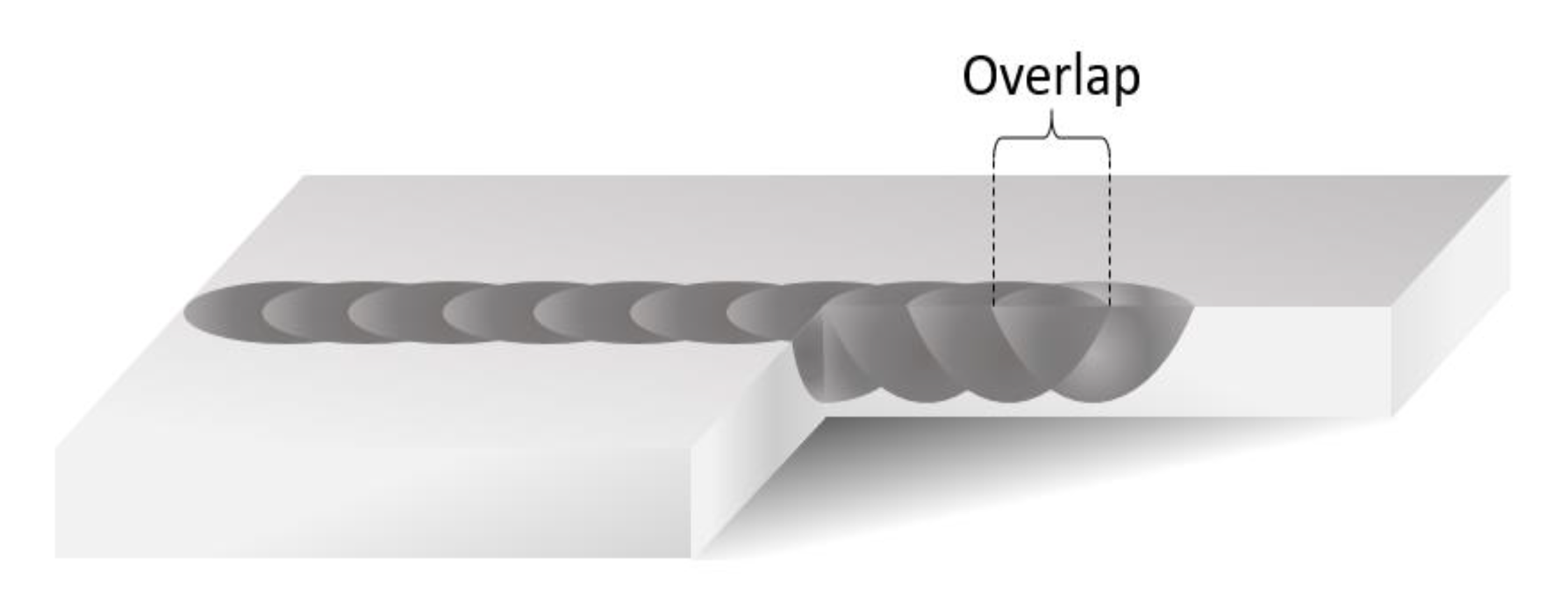


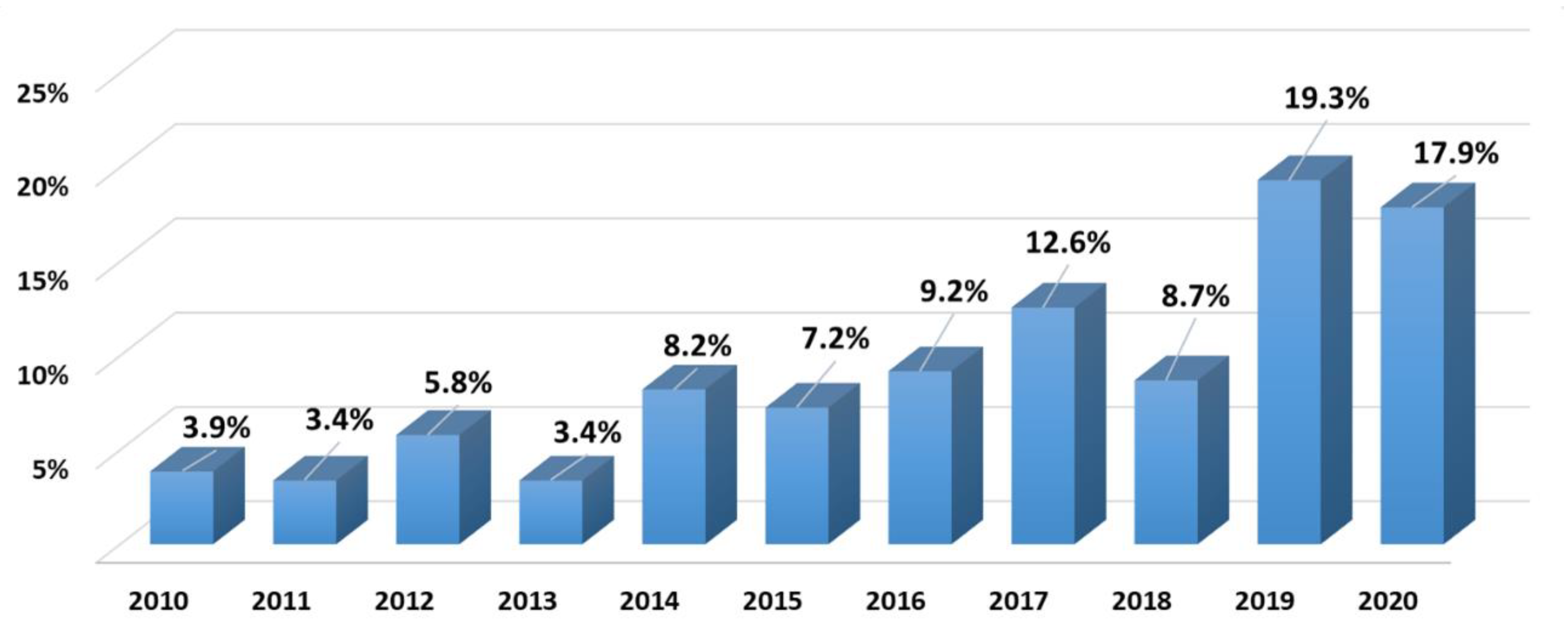
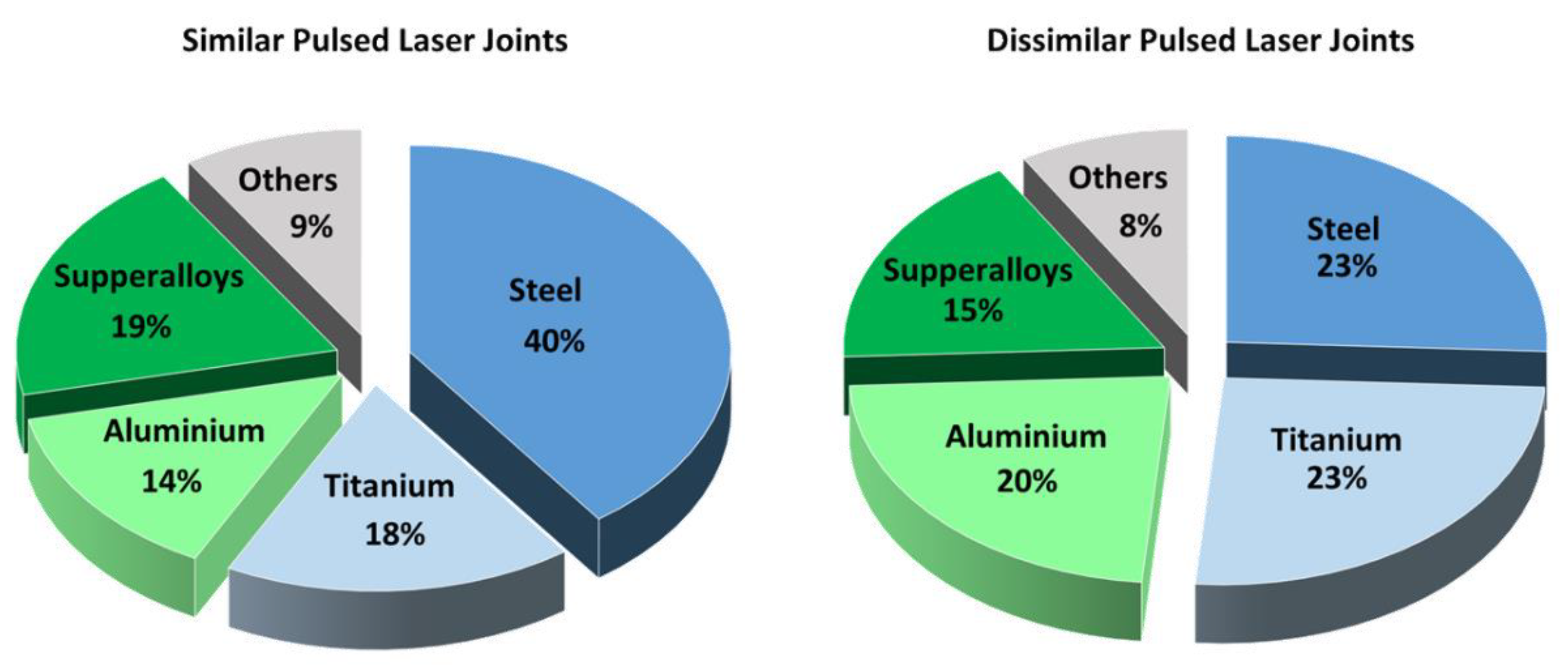

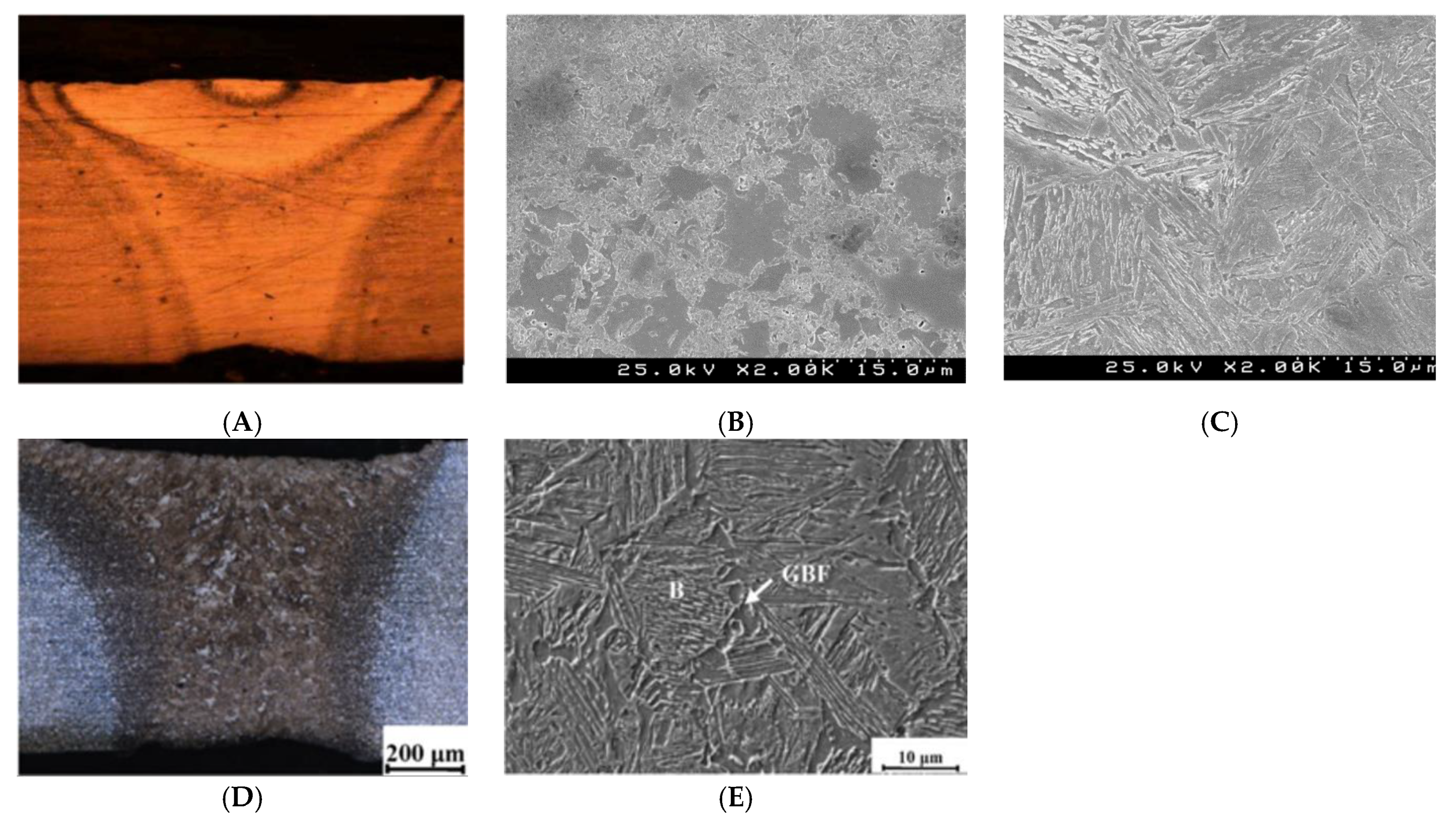
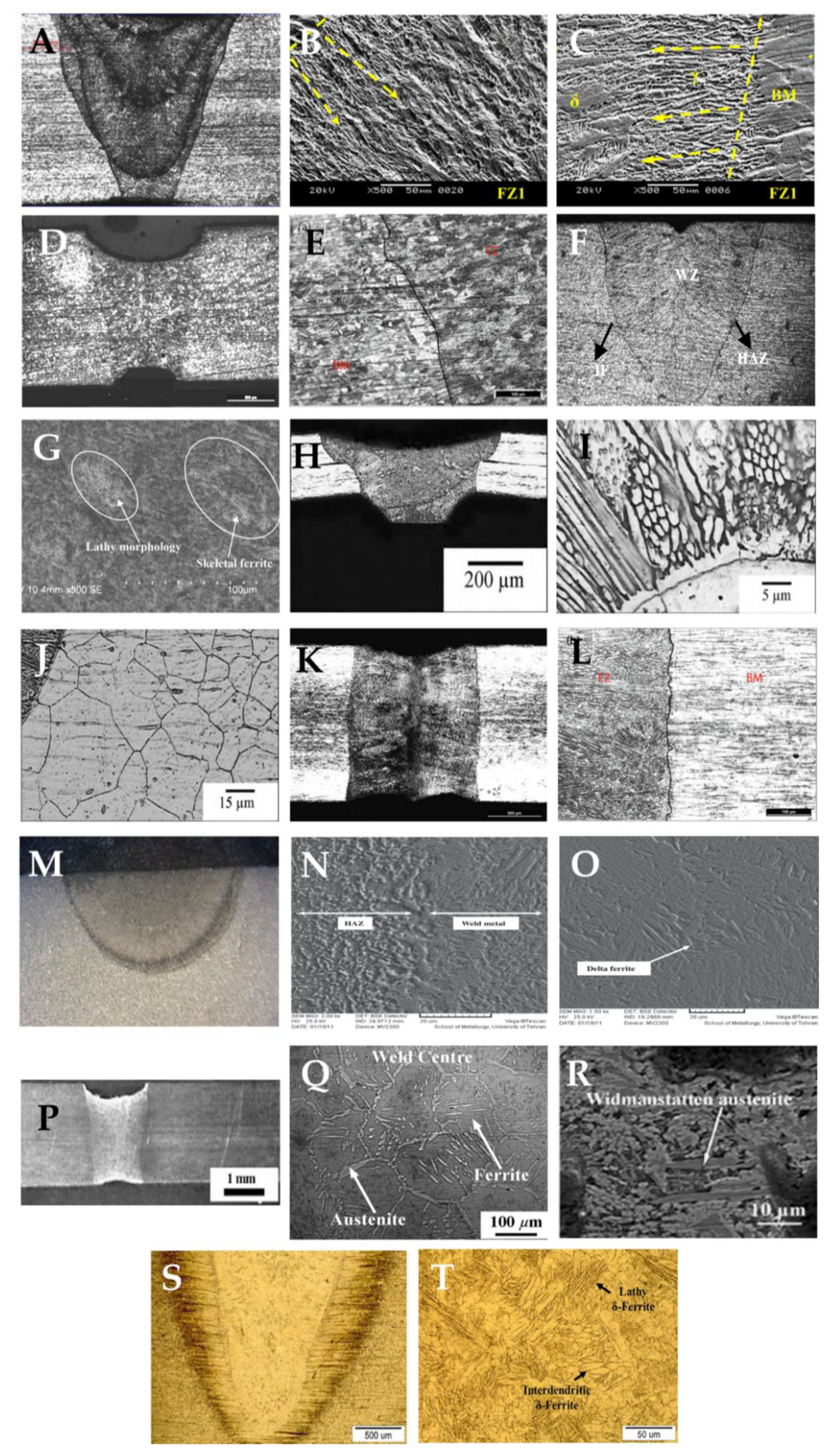
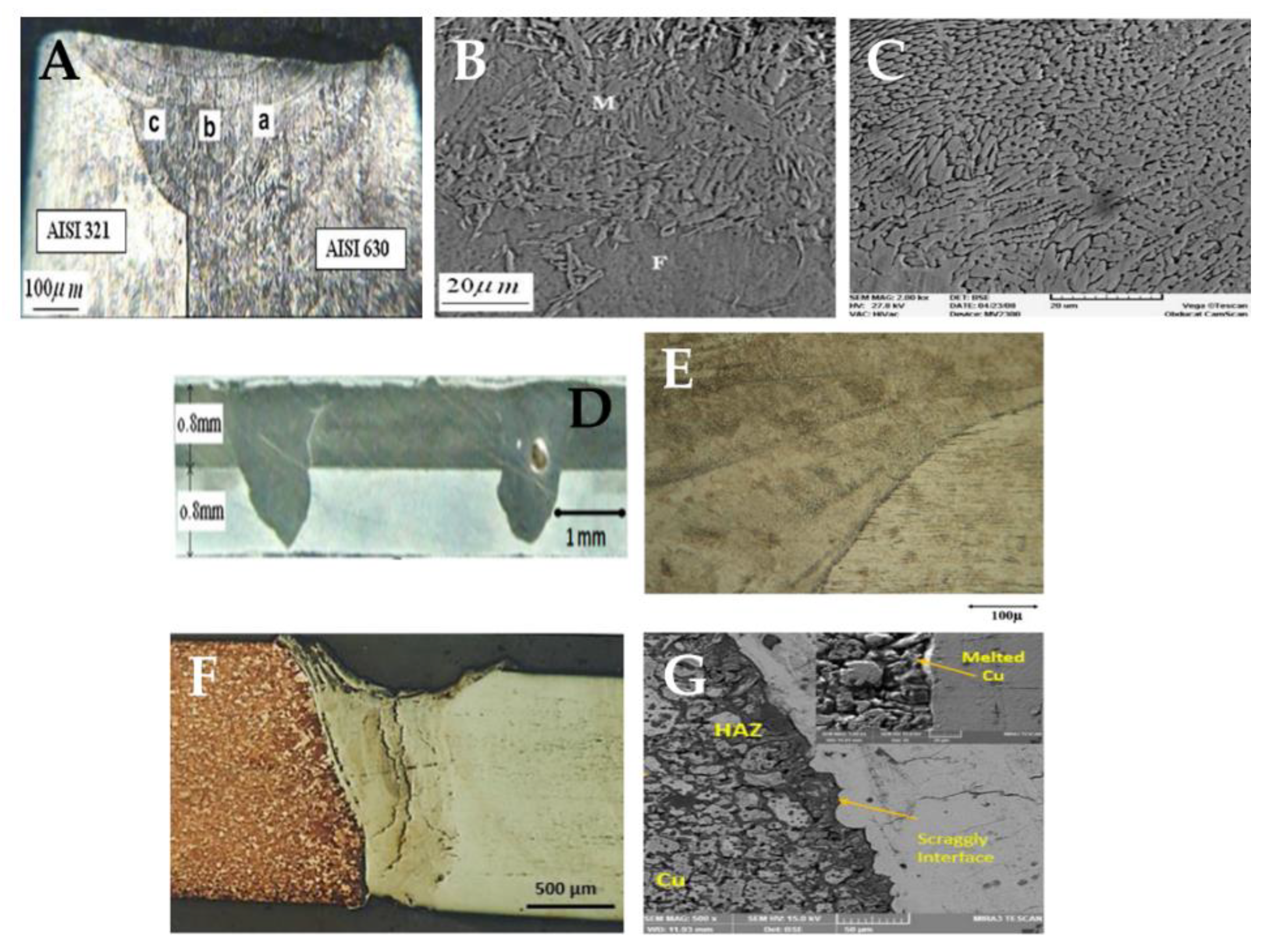


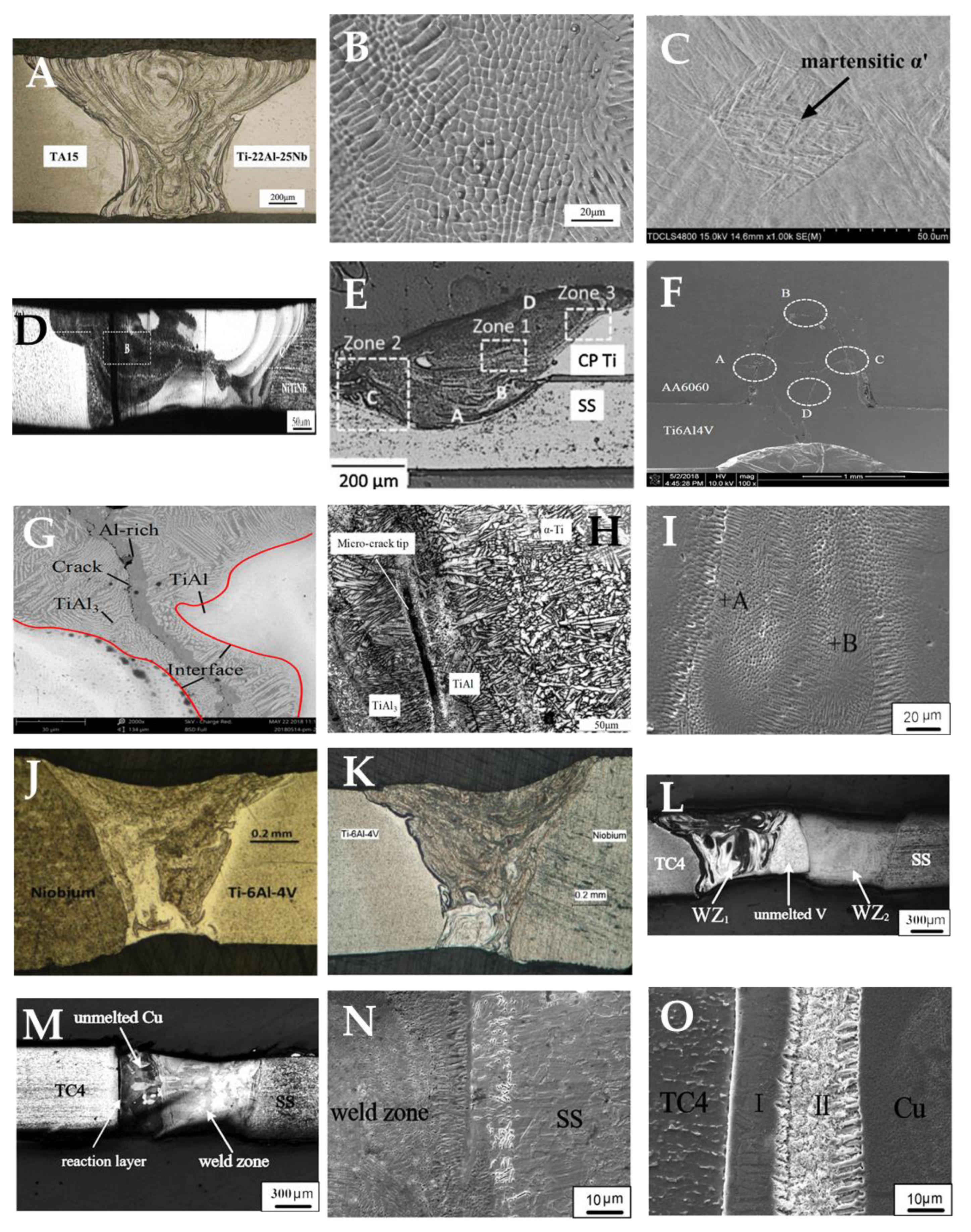



| Alloy | Hardness (HV) | Strength Performance | Ref. | |||
|---|---|---|---|---|---|---|
| FZ | HAZ | BM | Efficiency | Fracture | ||
| St37 | 193 | 168 | 115 | 312.0–96.3% | - | [52] |
| St14 | 280 | - | - | - | - | [53] |
| AISI 1005 | 390 | 250 | 120 | 287 MPa–93.7% | BM | [21] |
| S700MC | 394 | 335 | 281 | 770 MPa–100.0% | BM | [54] |
| TRIP | 275 | - | 315 | 795 MPa–94.0% | - | [55] |
| 22MnB5 | 535 | 200–460 | 200 | 501 MPa–99.0% | BM | [19] |
| DP1000 | 449 | 316 | 382 | - | - | [56] |
| DP600 | - | - | - | 611 MPa–91.0% | - | [58] |
| DP590 | 370 | - | 170 | 635 MPa–100.0% | BM | [11] |
| 301 | 253 | - | 235 | 833 MPa–99.0% | - | [45] |
| 304 | 180–250 | - | 160 | 708 MPa–112.0% | - | [17] |
| 304L | 210 | - | 180–210 | 600 MPa–88.0% | - | [7] |
| 301 | 254 | - | 234 | 980 MPa–98.0% | - | [45] |
| 316 | 195 | 215 | 165 | 477 MPa | - | [2] |
| 316 | 110–270 | - | 177 | 605 MPa–98.0% | - | [17] |
| 316L | - | - | - | 609 MPa–96.0% | - | [42] |
| 316L | 220 | 225 | - | 541 MPa–95.0% | - | [38] |
| 904L | 218 | - | 190 | 600 MPa–90.0% | - | [7] |
| 420 | 450–630 | 760 | 241 | - | - | [60] |
| 420 PWHT | 210–475 | 300–450 | 220 | - | - | [60] |
| 32750 | 180 | - | 120 | 785 MPa–105.0% | BM | [61] |
| 32750 | 375 | - | 330 | - | - | [62] |
| 17-4 PH | 440 | 450 | 400 | 995 MPa | BM | [64] |
| 17-4 PH PWHT | 520 | 480 | 420 | 1000 MPa | BM | [64] |
| Alloy | Category | Thickness (mm) | Joint Configuration | Pulsed Configuration | Equipment Power (W) | Pulse Energy (J) | Heat Input (J/mm) | Peak Power (kW) | Ref. |
|---|---|---|---|---|---|---|---|---|---|
| AISI 1005 | Low carbon | 1.70 | Butt | Overlap | 80 | - | - | - | [21] |
| AISI 1070 | High carbon | 1.30 | BOP 2 | Spot | 20 | 4.80–5.20 | 15.0–32.6 | - | [67] |
| St14 | Low carbon | 0.70 | Butt | Overlap | 400 | - | 19.0–29.0 | 1.10–2.75 | [53] |
| TWIP | Twinning-induced plasticity high-Mn | 1.00 | Butt | Overlap | 70 | - | - | 2.00–3.00 | [55] |
| 22Mnb5 | Ultra-high-strength steels | 1.60 | Butt | Overlap | 200 | 4.00–7.20 | - | 1.00–1.80 | [19] |
| DP1000 | Dual-phase high-strength steels | 1.00 | BOP 2/butt | Spot, overlap | 300 | - | - | 2.40–10.32 | [56] |
| DP600 | Dual phase | 0.80 | Butt | Overlap | 300 | 38.40 | - | - | [57] |
| DP600 | Dual phase | 1.00 | Butt | Overlap | 300 | 26.40 | - | - | [58] |
| DP 590 | Dual phase | 1.00 | Butt | Overlap | 300 | 8.80 | 5.5–30.0 | 1.60 | [11] |
| 301 | Austenitic stainless steel | 1.60 | Butt | Overlap | 600 | - | - | 0.35–0.55 | [45] |
| 304 | Austenitic stainless steel | 1.50 | Butt | Overlap | - | - | - | 0.40–0.49 | [17] |
| 304L | Austenitic stainless steel | 1.40 | Butt | Overlap | - | 17.00 | - | - | [7] |
| 316 | Austenitic stainless steel | 0.45 | Butt | Overlap | 250 | - | - | - | [2] |
| 316 | Austenitic stainless steel | 1.50 | Butt | Overlap | - | - | - | 0.40–0.49 | [17] |
| 316L | Austenitic stainless steel | 0.80 | Butt | Overlap | 70 | - | - | 1.65–1.85 | [42] |
| 316L | Austenitic stainless steel | 0.10 | Lap | Overlap | - | 1.00–2.25 | - | - | [38] |
| 420 | Martensitic stainless steel | 2.00 | Butt | Overlap | 100 | - | - | - | [60] |
| 904L | Superaustenitic stainless steel | 1.40 | Butt | Overlap | - | 17.00 | - | - | [7] |
| UNS S32750 | Super duplex stainless steel | 1.30 | Butt | Overlap | 600 | 29.00 | - | 0.50 | [62] |
| UNS S32750 | Super duplex stainless steel | 2.00 | Butt | Overlap | 550 | - | 120.0–330.0 | 0.50–0.55 | [61] |
| 17-4 PH | Precipitation hardening | 3.00 | BOP 2, butt | Spot, overlap | 300 | - | 60.0–129.0 | - | [64] |
| 321/630 | Stainless steel/precipitating hardness | 0.60 | Butt | Overlap | 80 | - | - | - | [63] |
| DIN 11010/304L | Low-carbon/austenitic stainless steel | 0.80 | Lap | Overlap | 400 | - | 12.9–19.3 | 1.50–2.20 | [65] |
| 304/Cu | Austenitic stainless steel/Cu | 1.50 | Butt | Overlap | 750 | - | - | - | [66] |
| Alloy | Hardness (HV) | Strength Performance | Ref. | |||
|---|---|---|---|---|---|---|
| FZ | HAZ | BM | Efficiency | Fracture | ||
| Ti6Al4V | 500–520 | 360–425 | 325 | 507.8 MPa–47.0% | - | [69] |
| Ti6Al4V | 360–370 | 340–350 | 324 | 1134 MPa–93.0% | BM | [72] |
| Ti6Al4V | - | - | - | 1138 MPa–102.0% | BM | [73] |
| Ti6Al4V | 375–390 | 350–400 | 320 | 1191 MPa–108.0% | - | [74] |
| Ti-2Al-1.5Mn | 235–280 | 235–275 | 215 | - | - | [76] |
| Ti-5Al-2.5Sn | 385–405 | 354–390 | 343 | 806 MPa–95.2% | BM | [75] |
| Ti49.4Ni50.6 | - | - | - | 683 MPa–95.0% | - | [77] |
| Ti3Al-Nb | 385–395 | 375–380 | 365 | 330 MPa–37.2% | FZ | [78] |
| Ti3Al-Nb Nb Filler | 355–375 | 375–380 | 365 | 724 MPa–81.7% | FZ/HAZ | [78] |
| Joint | Hardness (HV) | Strength Performance | Ref. | ||
|---|---|---|---|---|---|
| Alloys | FZ | BM | Efficiency | Fracture | |
| Ti-22Al-25Nb/TA15 | 271–290 | Ti-22Al-25Nb: 350 TA15: 320 | 1019 MPa 92.0% TA15 86.0% Ti-22Al-25Nb | FZ | [79] |
| Ti6Al4V/Nb | 175–300 | Ti6Al4V: 320 Nb: 80 | 269 MPa 29.2% Ti6Al4V 100.0% Nb | Nb/BM | [82] |
| Ti6Al4V/AA6060 | - | - | 43.3 MPa | - | [81] |
| CP Ti/304 | 550–750 | Ti: 150 304SS: 325 | 200 MPa 70.0% Ti | - | [37] |
| Ti6Al4V/301L with V interlayer | Ti6Al4V: 470 301L: 300 V: 160 | Ti6Al4V: 345 301L: 320 | 587 MPa | Ti–V interface | [84] |
| Ti6Al4V/301L with Cu interlayer | FZ: 315 Cu: 150 | Ti6Al4V: 345 301L: 320 | 320 MPa 35.7% Ti6Al4V 58.2% 301L | Ti/Cu layer | [85] |
| Alloy | Thickness (mm) | Joint Configuration | Pulsed Configuration | Equipment Power (KW) | Pulse Energy (J) | Heat Input (J/mm) | Peak Power (kW) | Ref. |
|---|---|---|---|---|---|---|---|---|
| Ti6Al4V | 0.80 | Butt | Overlap | - | 6.0–13.0 | - | - | [73] |
| Ti6Al4V | 0.80 | Butt | Overlap | - | - | - | - | [72] |
| Ti6Al4V | 1.50 | Butt | Overlap | - | - | - | 2.6–5.2 | [86] |
| Ti6Al4V | 3.00 | BOP 2 | Overlap | 0.75 | - | - | - | [70] |
| Ti6Al4V | 3.00 | Butt | Overlap | 0.60 | 5.6–13.4 | - | - | [69] |
| Ti-2Al-1.5Mn | 0.80 | Butt | Overlap | - | - | - | - | [76] |
| Ti-5Al-2.5Sn | 1.60 | Butt | Overlap | - | - | - | - | [75] |
| Ti49.4Ni50.6 | 0.20 | Butt | Overlap | 0.08 | - | - | - | [77] |
| Ti-24Al-15Nb | 1.00 | Butt | Overlap | - | - | - | - | [78] |
| NiTiNb/Ti6Al4V | Ni 0.3/0.2 Ti | Butt | Overlap | 0.08 | - | - | - | [80] |
| Ti22Al25/TA15 | 1.00 | Butt | Overlap | 4.00 | - | - | 1.3 | [79] |
| Ti6Al4V/Nb | Nb 1.00/0.85 Ti | Butt | Overlap | 0.40 | 9.0–18.0 | 27.0 | 1.5 | [82] |
| Ti6Al4V/Nb | Nb 1.00/0.85 Ti | Butt | Overlap | 0.40 | 9.0 | 27.0 | 1.5 | [83] |
| Ti6Al4V/Nb | Nb 1.00/0.85 Ti | Butt | Overlap | 3.00 | 15.0 | 37.5 | 1.5 | [83] |
| Ti6Al4V/AA6060 | Ti6Al4V 0.80/1.50 A6060 | Butt | Overlap | 0.30 | - | - | 12.0 | [81] |
| CP Ti/304 SS | 0.25 | Butt | Overlap | - | - | - | 4.5 | [37] |
| Ti6Al4V/301L | 0.80 | Butt | Overlap | 1.05 | - | - | - | [84] |
| Ti6Al4V/301L | 0.80 | Butt | Overlap | 1.05 | - | - | - | [85] |
| Aluminium Alloy | Hardness (HV) | Strength Performance | Ref. | |||
|---|---|---|---|---|---|---|
| FZ | HAZ | BM | Efficiency | Fracture | ||
| AA5052 | 58.6–65.6 | - | 60.1–70.5 | 140 N | - | [89] |
| AA5052 H3 | 105.0–120.0 | 85–105 | 80.0 | 168 MPa–73% | - | [9] |
| AA5456 | 95.0–100.0 | - | 115.0 | - | - | [26] |
| AA5456 PH | 75.0–85.0 | -- | 95.0–100.0 | - | - | [26] |
| AA5754-O | - | - | 180 MPa–90% | FZ | [93] | |
| AA6061 O | 76.0 74.0 * | 49 61 * | 45.0 | - | - | [99] |
| AA6022 T4E29 | - | - | - | 149 MPa–64% | FZ | [93] |
| Alloys | Hardness (HV) | Strength Performance | Ref. | |||
|---|---|---|---|---|---|---|
| FZ | Interface | BM | Efficiency | Fracture | ||
| AA6061 DP 600 | AA6061: 231 DP 600: 267 | AA6061: 501 DP 600: 419 | AA6061: 253 DP 600: 66 | - | - | [20] |
| AA5754 St14 | AA5754: 1150 St14: 200 | 1200 | AA5754: 100 St14: 150 | 180–300 MPa | - | [101] |
| AA1060 316L | 316L: 440 | 700 | AA1060: 35 316L: 180 | 46 MPa | Interface | [87] |
| Alloy | Thickness (mm) | Joint Configuration | Pulsed Configuration | Equipment Power (W) | Pulse Energy (J) | Heat Input (J/mm) | Peak Power (kW) | Ref. |
|---|---|---|---|---|---|---|---|---|
| AA5052-H32 | 0.600 | Butt | Overlap | 200 | 16.70–25.00 | - | 2.40–4.20 | [9] |
| AA5083 | 3.000 | BOP 2 | Spot/overlap | - | - | - | 2.30 | [98] |
| AA5083-H321 | 2.000 | BOP 2 | Overlap | 400 | 5.00–13.30 | - | 1.25–1.90 | [92] |
| AA5052 | 0.250 | BOP 2 | Overlap | - | 7.41–8.64 | - | 3.00–3.25 | [89] |
| AA5456 | 5.000 | BOP 2 | Overlap | 700 | 5.00–19.00 | 48.00–76.00 | 1.70–3.20 | [26] |
| AA5754-O, AA6022-T4E29 | 1.000 | Butt | Overlap | 2500 | - | - | 1.70–2.00 | [93] |
| AA2024-T4 | 2.000 | BOP 2 | Overlap/spot | 400 | 3.00–5.00 | - | 1.20–2.00 | [104] |
| AA2024 | 2.000 | BOP 2 | Spot | 400 | 6.00–10.00 | - | 1.20–2.00 | [96] |
| AA6061 T6 | 3.175 | BOP 2 | Overlap | 350 | - | - | 1.26–2.21 | [94] |
| AA6061 T6 | 0.500 | BOP 2 | Overlap | - | - | - | 1.50–1.90 | [95] |
| AA6061 O | 0.800 | BOP 2 | Overlap | 7200 | 4.80–5.90 | - | - | [99] |
| AA1100 | 1.000 | BOP 2 | Spot | 220 | - | - | 2.84–5.80 | [90] |
| A6061/DP 660 | 2.500/3.000 | Overlap | Overlap | 6000 | - | - | 4.00 | [20] |
| AA1050/DP 1000 | 1.000 | Overlap | Overlap | 300 | - | - | 6.00–8.40 | [103] |
| AA5457/St14 | 2.000/0.800 | Overlap | Overlap | 400 | 10.00 | - | 1.00–2.70 | [101] |
| AA1060/316L | 0.800 | Overlap | Overlap | 300 | - | - | - | [87] |
| AA1050/Cu1020 | 0.450/0.300 | Overlap | Overlap | 200 | 8.00–23.00 | - | 6.00 | [6] |
| AA2024-T851, AA6061-T4, AA5454-O, AA5083-H321 | 2.000 | BOP 2 | Overlap | 400 | 5.00–13.30 | 0.81–1.23 | 1.25–1.90 | [105] |
| Alloys | Hardness (HV) | Strength Performance | Ref. | ||
|---|---|---|---|---|---|
| FZ | HAZ | BM | |||
| UNS R30605 | 325 | 312 | 300 | 1021 MPa—101% Fracture: BM | [106] |
| Kovar/ 304L | Kovar: 200 304L: 250 | - | Kovar: 150 304L: 160 | - | [107] |
| Kovar/ 420 | Kovar: 250 420: 260 | Kovar: 150 420: 375 | Kovar: 150 420: 230 | - | [108] |
| Hastelloy X | 275 | 255 | 250 | - | [112] |
| Hastelloy C-276 | 260–300 | - | 240–280 | 759 MPa—90% | [109] |
| Hastelloy C-276/ Monel 400 | - | - | - | 719 MPa | [113] |
| Inconel 617 | 290 | - | 240 | - | [116] |
| Alloy | Category | Thickness (mm) | Joint Configuration | Pulsed Configuration | Equipment Power (W) | Pulse EW Energy (J) | Heat Input (J/mm) | Peak Power (kW) | Ref. |
|---|---|---|---|---|---|---|---|---|---|
| Kovar/304L | Fe–Ni–Co/stainless steel | 1.0 | Butt | Overlap | 90 | 4.8–5.2 | 15.0–20.0 | - | [107] |
| Kovar/420 | Fe–Ni–Co/stainless steel | 2.0 | Butt | Overlap | 100 | - | - | - | [108] |
| Hastelloy X | Ni–Mo–Cr | 0.5 | Butt | Overlap | 550 | 5.0–17.5 | 18.7–65.6 | 2.00–2.50 | [112] |
| Hastelloy C-276 | Ni–Mo–Cr | 0.5 | Butt | Overlap | - | - | - | - | [109] |
| Hastelloy C-276/ Monel 400 | Ni–Mo–Cr/Ni–Co | 0.5 | Butt | Overlap | 600 | 8.0–12.0 | - | - | [113] |
| Inconel 617 | Ni–Mo–Cr | 12.0 | BOP 2 | Spot | 100 | - | 15.7–22.3 | - | [116] |
| L-605 | Co–Cr–W–Ni | 1.4 | Butt | Overlap | 400 | 12.0–14.0 | 36.0–93.3 | 2.00–2.33 | [106] |
Publisher’s Note: MDPI stays neutral with regard to jurisdictional claims in published maps and institutional affiliations. |
© 2021 by the authors. Licensee MDPI, Basel, Switzerland. This article is an open access article distributed under the terms and conditions of the Creative Commons Attribution (CC BY) license (https://creativecommons.org/licenses/by/4.0/).
Share and Cite
Chludzinski, M.; dos Santos, R.E.; Churiaque, C.; Ortega-Iguña, M.; Sánchez-Amaya, J.M. Pulsed Laser Welding Applied to Metallic Materials—A Material Approach. Metals 2021, 11, 640. https://doi.org/10.3390/met11040640
Chludzinski M, dos Santos RE, Churiaque C, Ortega-Iguña M, Sánchez-Amaya JM. Pulsed Laser Welding Applied to Metallic Materials—A Material Approach. Metals. 2021; 11(4):640. https://doi.org/10.3390/met11040640
Chicago/Turabian StyleChludzinski, Mariane, Rafael Eugenio dos Santos, Cristina Churiaque, Marta Ortega-Iguña, and Jose Maria Sánchez-Amaya. 2021. "Pulsed Laser Welding Applied to Metallic Materials—A Material Approach" Metals 11, no. 4: 640. https://doi.org/10.3390/met11040640
APA StyleChludzinski, M., dos Santos, R. E., Churiaque, C., Ortega-Iguña, M., & Sánchez-Amaya, J. M. (2021). Pulsed Laser Welding Applied to Metallic Materials—A Material Approach. Metals, 11(4), 640. https://doi.org/10.3390/met11040640







